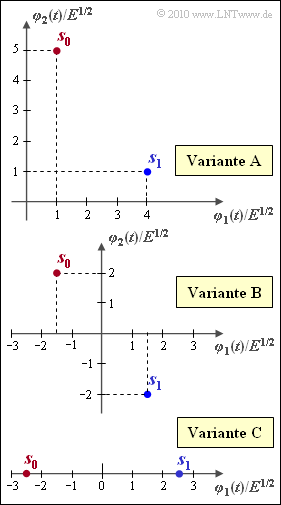Difference between revisions of "Aufgaben:Exercise 4.06Z: Signal Space Constellations"
From LNTwww
| Line 9: | Line 9: | ||
* Q(x) bezeichnet die komplementäre Gaußsche Fehlerfunktion (Definition und Approximation): | * Q(x) bezeichnet die komplementäre Gaußsche Fehlerfunktion (Definition und Approximation): | ||
:$${\rm Q}(x) \hspace{-0.1cm} \ = \ \hspace{-0.1cm} \frac{1}{\sqrt{2\pi}} \int_{x}^{\infty} {\rm e}^{-u^2/2} \,{\rm d} u | :$${\rm Q}(x) \hspace{-0.1cm} \ = \ \hspace{-0.1cm} \frac{1}{\sqrt{2\pi}} \int_{x}^{\infty} {\rm e}^{-u^2/2} \,{\rm d} u | ||
| − | \approx | + | \approx $$ |
| − | \hspace{-0.1cm} \ \approx \ \hspace{-0.1cm} \frac{1}{\sqrt{2\pi} \cdot x} \cdot {\rm e}^{-x^2/2} | + | :$$ \hspace{-0.1cm} \ \approx \ \hspace{-0.1cm} \frac{1}{\sqrt{2\pi} \cdot x} \cdot {\rm e}^{-x^2/2} |
\hspace{0.05cm}.$$ | \hspace{0.05cm}.$$ | ||
Revision as of 12:46, 7 November 2017
Die (mittlere) Fehlerwahrscheinlichkeit eines optimalen Binärsystems lautet:
- pS=Pr(E)=Q(d/2σn).
Hierzu ist anzumerken:
- Q(x) bezeichnet die komplementäre Gaußsche Fehlerfunktion (Definition und Approximation):
- Q(x) = 1√2π∫∞xe−u2/2du≈
- ≈ 1√2π⋅x⋅e−x2/2.
- d gibt den Abstand der beiden Sendesignalpunkte s0 und s1 im vorgegebenen Vektorraum an:
- d = \sqrt{ || \boldsymbol{ s }_1 - \boldsymbol{ s }_0||^2} \hspace{0.05cm}.
- \sigma_n^2 ist die Varianz des AWGN–Rauschens nach dem Detektor, der zum Beispiel als Matched–Filter realisiert sein kann. Es gelte \sigma_n^2 = N_0/2.
Durch die Grafik sind drei unterschiedliche Signalraumkonstellationen gegeben, nämlich
- Variante A : s_0 = (+1, \ \, +5), \hspace{0.4cm} s_1 = (+4, \ \, +1),
- Variante B : s_0 = (–1.5, \ \, +2), \, s_1 = (+1.5, \ \, –2),
- Variante C : s_0 = (–2.5, \ \, 0), \hspace{0.65cm} s_1 = (+2.5, \ \, 0).
Die jeweils mittlere Energie pro Symbol (E_{\rm S}) kann nach folgender Gleichung berechnet werden:
- E_{\rm S} = {\rm Pr}(\boldsymbol{ s } = \boldsymbol{ s }_0) \cdot || \boldsymbol{ s }_0||^2 + {\rm Pr}(\boldsymbol{ s } = \boldsymbol{ s }_1) \cdot || \boldsymbol{ s }_1||^2\hspace{0.05cm}.
Hinweise:
- Die Aufgabe gehört zum Themengebiet von Kapitel Approximation der Fehlerwahrscheinlichkeit.
- Wenn bei einer Teilaufgabe keine anderslautende Angabe gemacht ist, so kann von gleichwahrscheinlichen Symbolen ausgegangen werden:
- {\rm Pr}(\boldsymbol{ s } = \boldsymbol{ s }_0) = {\rm Pr}(\boldsymbol{ s } = \boldsymbol{ s }_1) = 0.5\hspace{0.05cm}.
- Die Normierungsenergie E ist hier stillschweigend zu 1 gesetzt.
Fragebogen
Musterlösung
(1)
(2)
(3)
(4)
(5)
